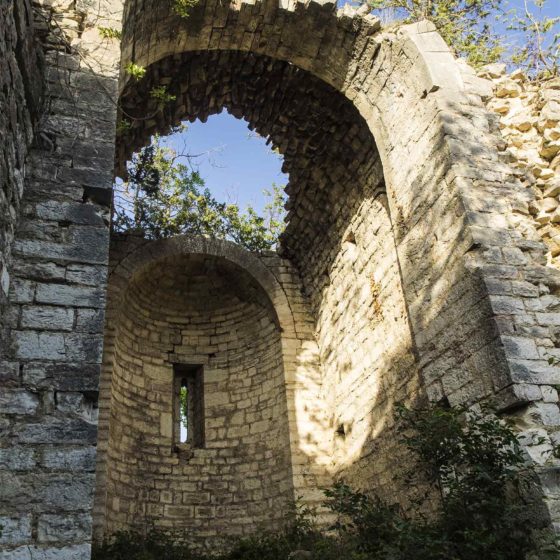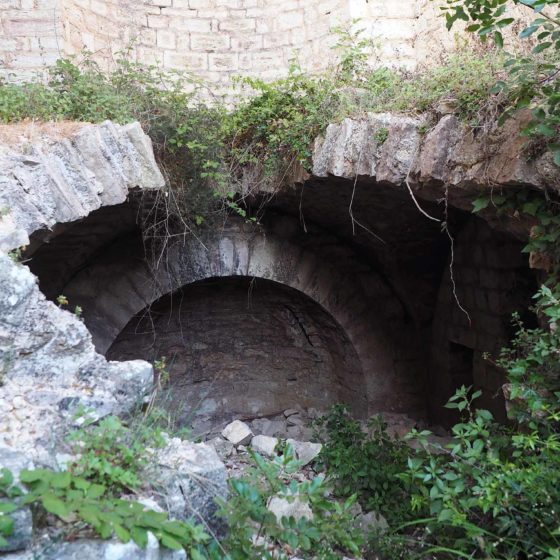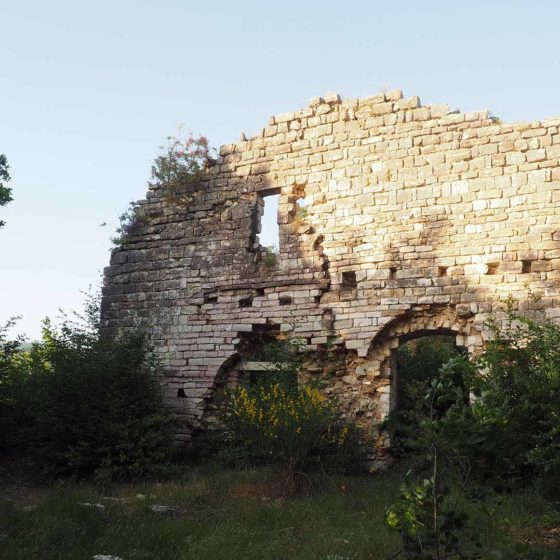Da una radura nel bosco che si apre lungo un’antica via che collega Matigge a Manciano, un breve sentiero ci conduce ai resti dell’antica abbazia di Santo Stefano di Manciano.
Eretta sul versante settentrionale della montagna di Matigge, a una quota di m 527 s.l.m., l’antica struttura è nascosta nel fitto della vegetazione boschiva in una posizione isolata e piuttosto distante dai più vicini centri abitati della montagna trevana.
Questo edificio di culto risale circa al XII secolo, con un ampliamento forse riferibile al secolo successivo di cui restano, tuttavia, solo pochi elementi.
All’interno dei ruderi è ancora visibile parte della cripta a sala unica e pianta quadrata con i resti del presbiterio sopraelevato e dell’abside semicircolare.
La chiesa era annessa a un’abbazia più antica, la cui fondazione si fa risalire circa al 600 d.C.
Secondo le memorie popolari fu centro di culto ricco di beni preziosi.
I documenti storici legano questa chiesa all’ordine dei Benedettini, anche se nei resoconti della visita pastorale del Lascaris si cita la presenza di monaci dell’ordine degli Umiliati.
Lo Jacobilli narra che il 18 ottobre del 1318 l’abate Pietro, non riuscendo a riportare i monaci di Santo Stefano di Manciano alla pura osservanza della regola «[…] per esser nel capo, e nelli membri dissoluto, diruto e diformato nelle persone e nella robba et oppresso nel spirituale, e nel temporale […]», decise di annettere questa abbazia a quella di Sassovivo. Nel 1429 Santo Stefano risulta abbandonata e nel 1571 il vescovo De Lunel la descrive priva di pavimento e «[…] in indecenti loco, et satis remoto, et separata a prefata villa […]».
A causa della distanza della vecchia abbazia da Manciano, gli stessi abitanti della frazione chiesero di avere una chiesa in posizione più comoda e vicina al centro abitato.
La nuova struttura fu eretta nel 1595 e dedicata al Salvatore, mentre Santo Stefano fu definitivamente abbandonata.
Ancora oggi, la popolazione di Manciano festeggia come patrono santo Stefano, mentre nel mese di settembre, con celebrazione finale l’ultima domenica del mese, solennizza la Madonna del Rosario.
La visita ai resti dell’antica abbazia di Santo Stefano si può abbinare a una bella escursione che parte dalla Torre di Matigge, giunge alla chiesa di San Nicolò, prosegue verso i resti di Santo Stefano e si inoltra verso la chiesetta di San Martino, attraversando meravigliosi castagneti e diverse località di Manciano.
TREVI, MANCIANO, RUINS OF THE ABBEY CHURCH OF SANTO STEFANO (AND CURRENTLY - EX - PARISH CHURCH OF SAN SALVATORE)
Through a woods and then to a great opening along an ancient road that connects Matigge to Manciano, a short path leads us to the ruins of this ancient abbey of ‘Santo Stefano di Manciano’ (Saint Stephen of Manciano).
It was erected on the northern side of the Matigge mountain, at an altitude of about 527 m (above sea level).
The ancient structure of this building is hidden among the forest vegetation in an isolated position and quite far from the nearest small hamlets all along the mountain of Trevi.
This building dates back to the 12th century, with an expansion attributable to the following century, but unfortunately only a few elements remain of it .
Anyway, part of the single-room crypta and square planned area togheter with the ruins remains of the presbytery and the semicircular apse are still visible inside the ruins.
The church was an annexed building to an older abbey, whose foundation dates back to around 600 AD.
According to popular memories it was a center of worship rich in precious goods.
Historical documents link this church to the Benedictine Order, even if in the reports of the pastoral visit of Lascaris the presence of monks of the order of the Humiliated is mentioned.
Jacobilli narrates that on October 18th, 1318 Abbot Pietro, unable to bring the monks of Santo Stefano of Manciano back to the pure observance of the rule, leading a mostly dissolute life, decided to annex this Abbey to that of Sassovivo.
In 1429 the church of Santo Stefano was abandoned and in 1571 the bishop De Lunel described it without a floor and in an unacceptable condition also because it was too far from the inhabited centers.
Due to its distance from Manciano, the community asked to have a church in a more comfortable position and close to the inhabited center.
A new church was built in 1595, dedicated to the Savior, while Santo Stefano was definitively abandoned.
Still today the population of Manciano celebrates Saint Stephen as the patron, while in September, with a final celebration on the last Sunday of the same month, they honor the Madonna of the Rosary.
The visit to the ruins of the ancient abbey of Santo Stefano can be combined with a nice excursion starting from the location ‘Torre di Matigge’, reaching the church of San Nicolò, continuing towards Santo Stefano and proceeding towards the church of San Martino, through lovely chestnut groves and several localities of Manciano.
The translation of this post is edited by Patrizia ANTONELLI


